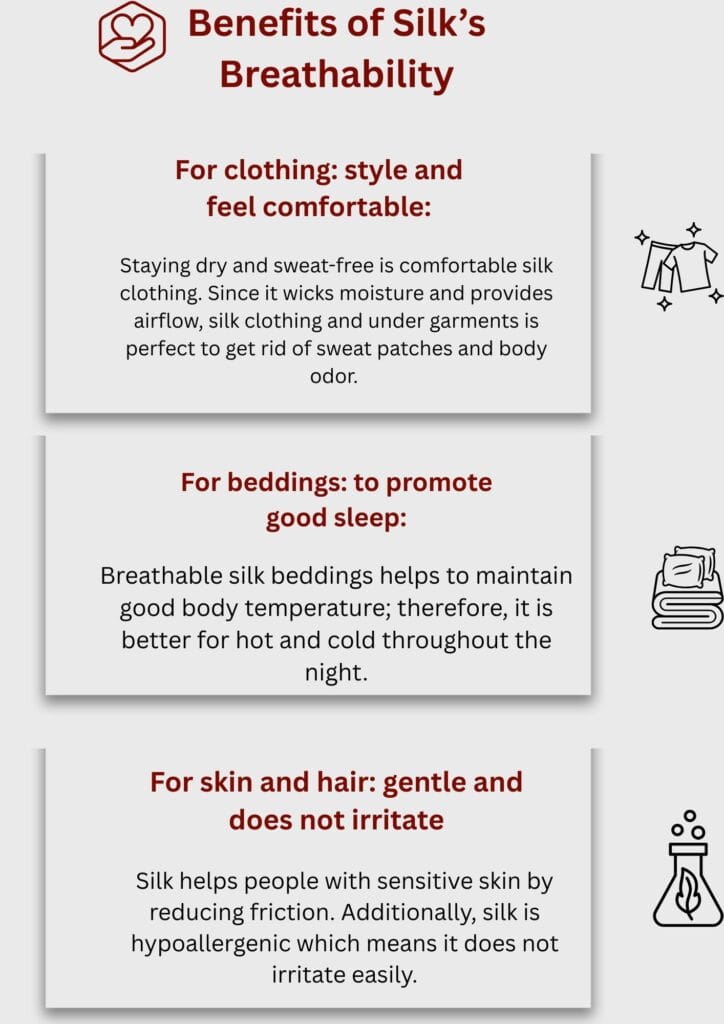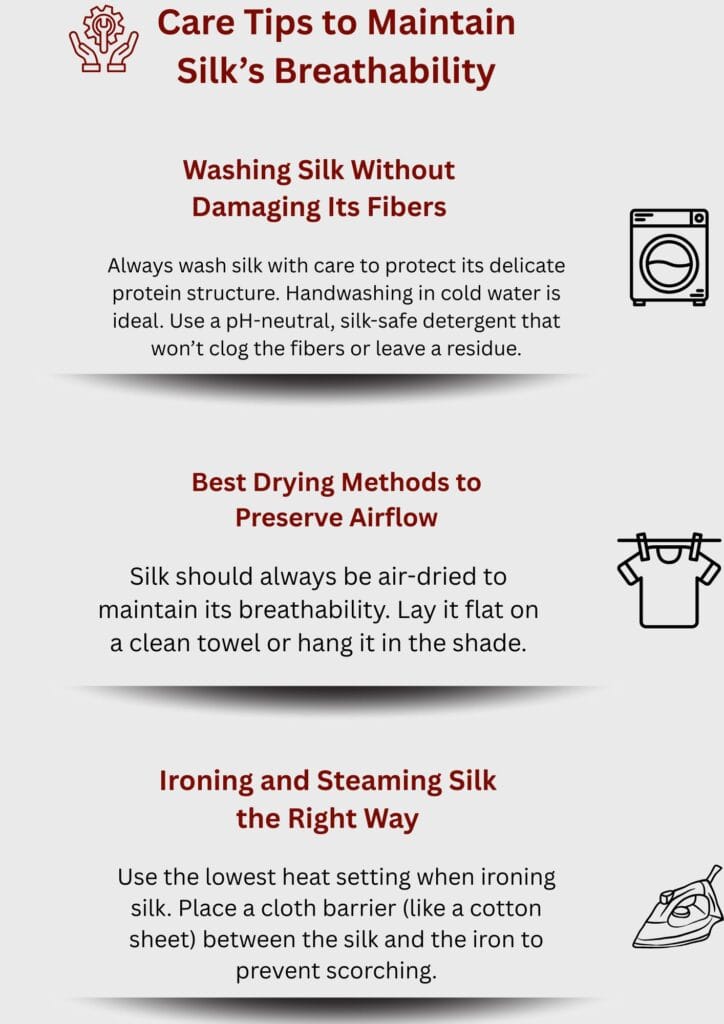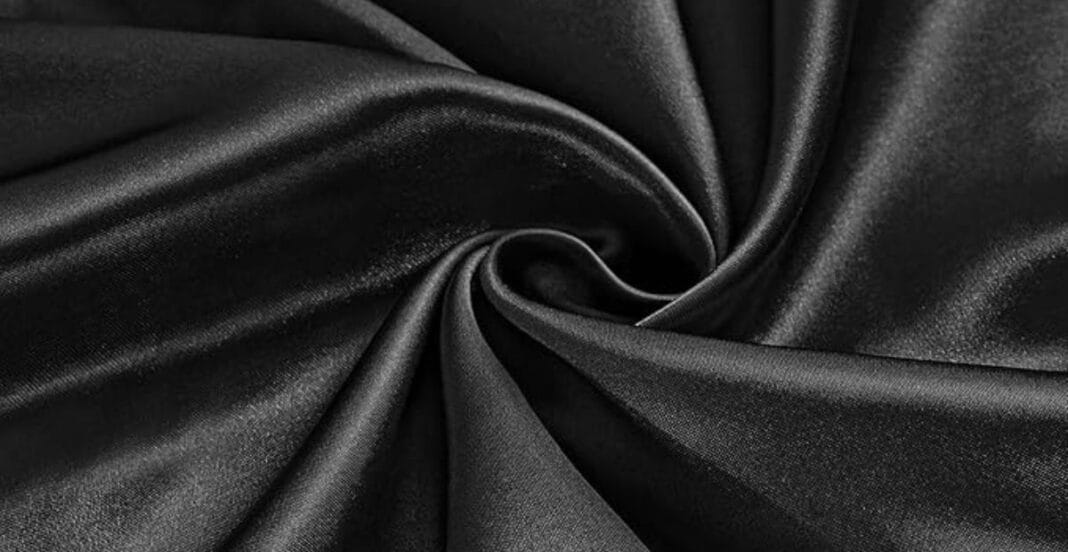Introduction
Silk is a wonderful natural fiber because of its smooth texture, a glossy sheen, and delicate feel. But is silk breathable? As comfort and health is important nowadays, silk is a breathable silk. Breathability of silk as a fabric determines its temperature and moisture regulation, directly affecting one’s feeling while wearing it or sleeping.
Silk is used in making blouses and other clothing items, scarves, lingerie, and even sleepwear. It also has a place in bedding with pillowcases, sheets, and duvet covers. Even with its expensive reputation, many people still question if silk has the same cooling and air friendliness as more casual fabrics like cotton and bamboo.
Which Factors Increase Silk Breathability?
Silk’s Natural Protein Structure
Silkworms produce fibroin, a natural protein silk is composed of. Silk’s breathability is attributed to fibroin’s thin and strong silk fibers with microscopic gaps. These gaps enable air and moisture to go through the fabric, keeping the wearer cool and dry.
Silk is a natural fiber and does not trap heat like synthetic fabrics. It is also a natural fiber and does not trap heat, making its protein composition beneficial in regulating body temperature, especially during summer or winter.
Moisture-Wicking Properties
Silk does not only feel soft; it actively pulls moisture away from skin. Silk may keep the surface dry even in warm and humid conditions. Sweat can also evaporate easier, which helps stave off the sticky or clammy feeling some fabrics can create.
Wool can also feel itchy or retain odor, and cotton does not breathe as easily as silk does. While silk does not trap heat or moisture as roughly as polyester, it is also much easier to wear than cotton, which breathes well but retains moisture.
Scientific Explanation of Silk’s Breathability
Thermoregulation Abilities
Silk can have different effects on the human body depending on the season. In the warm months, it can allow body heat and warm air to escape. In the colder months, silk can trap warm air close to the skin. This makes silk one of the few fabrics that perform well all year round.
Silk can perform much better than synthetic fibers like polyester, which struggle to warm or cool the wearer. Silk is protein-based, and works in harmony with your body’s needs.
Porous Fiber Construction
These microscopic pores allow air and moisture to pass and can help improve comfort.
This airflow helps to reduce the amount of bacteria on your skin, preventing long lasting infections. If you’ve slept on a silk pillow case, you would have noticed how refreshing and cooling it is.
Benefits of Silk’s Breathability

For clothing: style and feel comfortable:
Staying dry and sweat-free is comfortable silk clothing. Since it wicks moisture and provides airflow, silk clothing and under garments is perfect to get rid of sweat patches and body odor. It is best suited for undergarments, summer dresses, and shirts.
Additionally, silk clothing is great to have on because it is lightweight, making traveling, spending time outdoors and warm climates more comfortable.
For beddings: to promote good sleep:
Breathable silk beddings helps to maintain good body temperature; therefore, it is better for hot and cold throughout the night.
Better airflow leads to less night sweat, which is especially helpful for women experiencing menopause.
For skin and hair: gentle and does not irritate
Silk helps people with sensitive skin by reducing friction. Additionally, silk is hypoallergenic which means it does not irritate easily. It allows skin to breathe and moisture does not turn to bacteria under silk.
Hair benefits too since silk is smooth, hair becomes frizz and breakage free.
Is Silk More Breathable Than Cotton or Bamboo?
Comparison with Cotton and Bamboo
Though cotton is known for being breathable, it tends to hold onto moisture for longer than silk does. While it does absorb perspiration, it does not dry quickly. Bamboo is another excellent breathable fabric, often mixed with other fabrics for added comfort.
Still, silk is unique with its lightness and breathability, as well as its ability to control temperature. Silk fabric dries quickly and does not feel damp on the skin.
Mulberry Silk vs. Other Types
The highest quality silk, mulberry silk, is made from Bombyx mori silkworms who are exclusively fed mulberry leaves. Because of the long fibers and uniform texture, mulberry silk is the most breathable silk.
Wool Tussah or Eri silks tend to be rougher, and are less breathable due to their coarse weave and shorter fibers.
Does Silk Help with Night Sweats?
Yes, silk is one of the best fabrics to use for night sweats. Because silk is breathable, it allows heat to escape, and its moisture-wicking properties keep the skin dry. Because both functions help provide heat for the body, sleep is more restful.
Those suffering from hot flashes, hormonal changes, or feverish conditions find relief when switching to silk beddings. Silk does not act like synthetic materials, which trap heat and moisture. Because silk is breathable, it does not retain heat or moisture.
Tips for Picking the Most Breathable Silk Products
Look for Ideal Momme Weight
When buying silk, check the momme weight which signifies the silk’s thickness. For durable and breathable silk, a momme range of 19-22 is ideal. Lighter mmomes will breath better, but can become damaged quickly, and heavier will retain and trap heat.
Opt for 100% Mulberry Silk
Cheaper varieties of silk tend to mix real silk with polyester or rayon. These synthetic additives reduce breathability and comfort. While pure silk is more expensive, it is pricless in the long run as it provides better airflow and long term benfits.
Avoid Synthetic Blends
Always pick products made from 100% Mulberry silk as it’s the most breathable type of silk. While checking on the products, make sure to look for labels with OEKO-TEX certified labels for silk free of chemicals.
Common Myths About Silk Breathability
“Silk Makes You Sweat More”
Silk actually pulls moisture from the skin and allows it to evaporate, which is opposite to the claim that, “Silk Makes You Sweat More.” Silk does not trap perspiration as polyester or nylon does, so it’s cooler than cotton or synthetic blends.
“All Silk is the Same”
momme, types, and weaves, the specific type, weave, and the momme weight will dictate quality, breathe. While charmeuse weave is lighter and satin weaves are heavier and bulkier (heavier than satin weaves), satin weaves are not breathable and heavier than charmeuse weave.
Best Silk Products for Breathability
For those looking to refresh their wardrobe or bedroom with breathable silk, consider these highly recommended choices:
Best Silk Products for Breathability
- Sip Pillowcases: Assist with cooling, skin, and hair during sleep.
- Sip Pajamas: Fits snug and lightweight for those summer nights.
- Sip Scarves: Perfect for accessorizing in during the summer.
- Sip Sheets: Sumptuous silk for nightly luxury and comfort throughout the night.
For these items, consider purchasing from brands that guarantee 100% Mulberry silk with eoeko-tex standard certification. Do not purchase products claiming to be “silk” that are really polyester instead.
Care Tips to Maintain Silk’s Breathability
silk products require proper care in order for breathability to be maintained.

- for silk, use a mild, ph-neutral detergent and cold water to wash.
- best is to hand wash, however, putting in a mesh bag and doing delicate cycle in washing machine also works.
- avoid using bleach or harsh chemicals that wear down the silk’s protective micro mesh.
- hang drying silk in the shade protects the silk’s protein fibers from damage.
- iron or steam at low temperature to preserve silk’s structure and bonds while avoiding damaging the silk’s bonds.
following these with proper care ensures breathability and longevity.
Conclusion
Breathability of silk is remarkable and stands out for the unique structure of its proteins. Its moisture-wicking ability coupled with air-friendly fibers makes it appropriate for clothing, bedding, and personal care. While cotton and bamboo provide respectable levels of breathability, silk does so luxuriously while offering additional benefits to one’s skin and hair.
To enjoy silk’s full breathability, select high-quality Mulberry silk with the right momme weight and gentle care. For those with night sweats, skin sensitivities, or hot summers, silk is a smart and stylish solution.
FAQs
silk is ideal for summer. It permits the free flow of air, and in addition, absorbs sweat without becoming damp.
No. Silk actually maintains body heat and prevents overheating, especially in the case of silky bedding. Silk does not trap heat.
Yes, silk is very gentle and breathable. It is also hypoallergenic, which is important for babies suffering from sensitive skin or eczema.
Yes, because silk does not harbor as much irritating bacteria as cotton or synthetic fibers, silk pillowcases reduce inflammation and breakouts by lowering friction.


